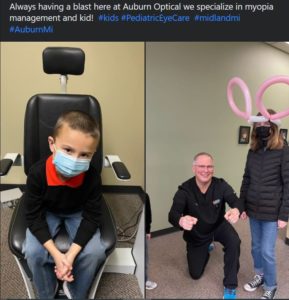February 1, 2022
By Matthew Martin, OD, FIAOMC
Whenever we have a new patient, I always ask them why they chose us. The answer is almost always the same: Google reviews and online content.

Dr. Martin hopes that his practice’s social media channels reflect that his office is kid-friendly and parent-friendly.
There is no escaping social media’s influence on your practice and your patients. These days it’s easy to see why your practice has to have a strong social media presence. When considering social media and its outsized influence on your practice, there are some key points to keep in mind: goals, culture, reputation, and etiquette.
Outlining Goals
Before you begin tackling your social media presence, consider your goals for this effort. Defining what you hope to achieve before you start is an excellent way to make sure you have continued success. Feel free to create both long-term and short-term goals, and be specific. For example, some goals might be to increase myopia management patients in your office, have at least two or more myopia management evaluations per week, or increase outreach to the Asian community in your area. With these goals guiding your efforts, it’s time to share your office’s culture with the world.
Communicating Your Office Culture
When creating or redefining the social media presence for your office, nothing is more important than the culture you share. For the purposes of this discussion, I am defining “culture” as the shared beliefs, values, and environment of your office. The culture of your office is what makes your office unique and sets it apart from other offices in your geographic area. Many myopia management practices will include skewing social media toward parents and their children. After all, the success of your specialty is directly dependent on the volume of young myopic children in need of your services. Toward this end, your social media needs to emphasize that your office is kid-friendly and parent-friendly.
For our office, we make sure that at least 60% of our social media posts contain children, and the culture is built around making children comfortable as patients. For example, I make balloon animals for children 10-years-old and younger — for those not allergic to latex. When parents allow (which is close to 90% of the time), we take a quick photo of these happy kids and post it to social media. This allows parents to “check in” on Facebook and often leads to a positive review of our practice.
Maintaining Your Online Reputation
In this modern age of internet consumption, nothing is more powerful than your online reputation. Many of us, myself included, would never think about purchasing an item or consider using a service without first reviewing what’s being said about it online. Google reviews, Facebook reviews, and your online reputation are the driving force behind why a person would choose you as their health care provider. Parents are even more selective when considering health care choices for their children. This all starts with an active and thorough Google page.
As a business, establishing a Google presence is easy and quick. Simply searching “how to establish a business” on Google is the first step. Being as thorough as possible in the description of your business, including hours, policies, how to make an appointment, and sharing some of your practice’s culture is the first step. Advanced efforts can and should include copious amounts of pictures, blogs, articles, and exciting content related to your specialty. Having a Google page allows the users of your services to review your practice then.
I often get new patients who come to our rural office from surprisingly distant areas. Some of these patients travel 20 miles or more and drive by many competing offices. Whenever we have a new patient, I always ask them why they chose us. The answer is almost always the same: Google reviews and online content. I recently took some time to look at my local competition and assess their reviews. I was surprised by both the volume and the overall rating. Some of my competition had as few as four reviews, and very few had more than 100; many of the reviews were not favorable.
From this, I learned some lessons and some actionable intelligence. Whenever you have a positive experience with a patient, ask for a review. Some will gladly go online and write about their experience; however, most won’t. But if you do this often enough, you will slowly build a deep pool of positive reviews. This large pool will help insulate you from the occasional negative person who will try to ruin your reputation by leaving a very poor review over a minor, quickly resolved issue — which they chose not to get help resolving. Speaking of resolving issues, don’t respond to a bad review aggressively. Always respond in a manner that indicates you look forward to resolving their problem and will reach out to them promptly to accomplish this goal. Even if you cannot satisfy them, the social media consumer will understand that you tried to give the customer the satisfaction they desire.
Understanding Social Media Etiquette
Never put anything on social media that you would not like to see on a billboard in front of your grandmother’s house. That includes politics, religious opinions, and stances on hot-button issues. Remember: there is a time and place for your views and social commentary. However, your practice’s social media profile is not the place for this.
















